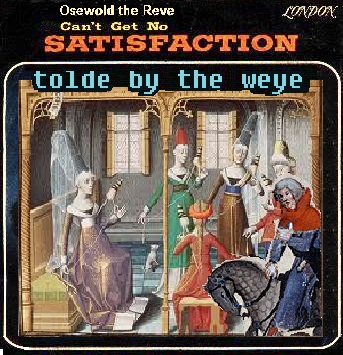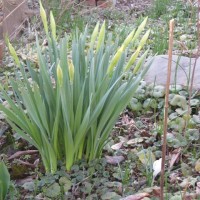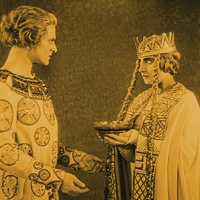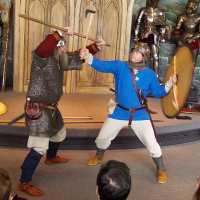
Languages have a way of changing. Certain words and expressions adapt – sticking with us for centuries – while others disappear entirely. Here are five Middle English expressions we no longer use:
1. Drunken as a Mouse
This expression is probably best known from its appearance in Chaucer’s Knight’s Tale[1] – the first Canterbury Tale. There’s no doubt this expression comes from the peculiar state cellar mice were found in after gnawing on wooden casks of wine or ale. Though aging ale in wooden casks is starting to make a comeback in home and craft brewing, mice haven’t been associated with beer in popular culture since Bob and Doug McKenzie used one in a bottle to try to get a free case of Elsinore beer.

Bob and Doug McKenzie (played by Rick Moranis and Dave Thomas) try to get a free case of beer using a mouse in a bottle in the film Strange Brew (copyright 1983 MGM).
The expression later became “Drunk as a skunk” – probably only because it rhymes. When’s the last time you’ve heard anyone say, “Drunk as a skunk” anyway?
2. Breme as bore
Brave (or fierce) as a boar. It appears in The Middle English Stanzaic Morte Arthur[2] where it is used several times to describe how awesome certain knights of King Arthur’s court are at jousting. I wouldn’t want to be on the receiving end of a lance driven by a knight who was as “breme as a boar.”
This expression is one of my personal favorites and I’d love to bring it back. Problem is, “breme” didn’t make it to our Modern English. I suppose we could use “brave as a boar” but it just doesn’t have the same ferocious ring to it. Plus, how often does a wild boar come up in conversation anymore? Though they seem to always be around in Middle English and Middle High German texts, we rarely hear of run-in’s with wild boars these days – unless, of course, they are Sylvester Stallone legends from Bulgaria.
3. They walwe as doon two pigges in a poke
They wrestled like two pigs in a poke. Chaucer used this expression to animate the cartoonish climax of his Reeve’s Tale. Symkyn the Miller and Alalyn are in a fight cloud like pigs in a poke until Symkyn slips on a stone, falling backward onto his wife in bed giving Alayn and John the chance to get out of Dodge.
Growing up in the American South, I occasionally heard the expression “like two pigs in a poke” but, famously getting expressions wrong and not knowing that a “poke” was a sack – I thought it meant something along the lines of two pigs trying to pass a threshold at the same time – not wriggling around in a sack.
The closest I’ve ever come to seeing this expression acted out was in West Africa. Once, when my wife and I were en route from either Grand Popo or Porto Novo to Cotonou, the taxi driver stopped at a roadside stand to load some pigs in the trunk. We could hear – and sometimes feel – their wrestling behind us for the entire journey.
When we finally reached Cotonou, the driver stopped at a Barbeque stand where the pigs were unloaded for a big lady who oversaw the removal of the beasts from the back of our vehicle looking stern and unimpressed. We were surprised to see that there were actually three pigs in the trunk instead of two. Though it greatly annoyed the other two ladies who were stuffed like sardines in the backseat with us – we were lucky we kept our backpacks on us instead of storing them in the trunk.
4. Not worth a leek
Chaucer used this expression in his Wife of Bath’s lecture on marriage. The entire line is:
I holde a mouses herte nat worth a leek
That hath but oon hole for to sterte to
And if that faille, thane is al ydo. (D ll. 572-74)
This basically means marriage is like a mouse who only has one hole. If the mouse loses his hole, he has nothing. It’s a long way of a saying, “Don’t put all of your eggs in one basket” – which we could use on one level to sum up the entire Wife of Bath’s Prologue. I’m not talking about the entire sense of these compound expressions though. Instead, I’m looking specifically at the expression “not worth a leek.” I’ve only seen that expression in Middle English texts. We don’t use “not worth an onion” (another one Chaucer often uses) and “not worth a leek” anymore. We’ve replaced them, at least in America, with “not worth a dime.” Why is that so?
5. Whoso that first to mille comth, first grynt
I wasn’t intending to give Wife of Bath two spots on this list, but her work is chock full of witty expressions. We know what “First to the mill, first to grind” means, but we never hear it used today. Since everyone in a 14th century village needed their grain ground (whether they farmed it or not) on a regular basis, people spent a lot of time waiting their turn to get this done. We no longer rely on the miller to save us from grinding grain by hand all day.
We’ve since replaced this expression with “the early bird gets the worm” or “first come, first serve.” Many Americans will be thinking about this expression come Black Friday and as Christmas shopping season ramps up even more – I doubt they’ll use the words “first to the mill is first to grind”, but they will be thinking the same thing.
[1] References to Chaucer in Middle English are taken from Chaucer’s Major Poetry, Ed. Albert C. Baugh (New York, 1963).
[2] The Stanzaic Morte Arthur from King Arthur’s Death: The Middle English Stanzaic Morte Arthur and Alliterative Morte Arthure, ed. Larry D. Benson, (Indianapolis: Bobbs-Merril, 1974).















